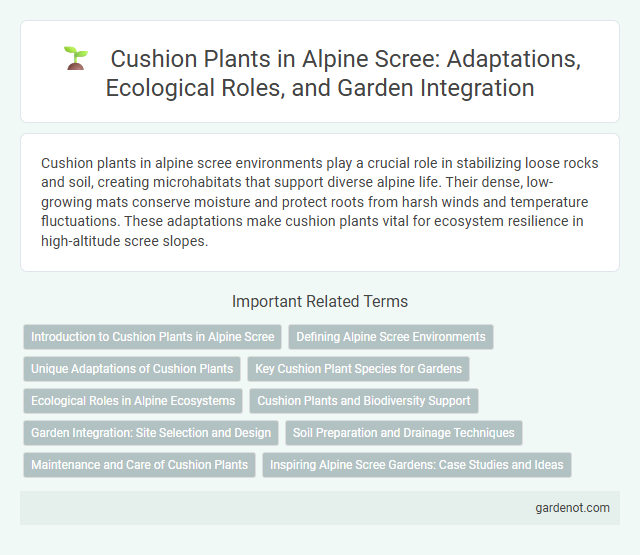Cushion plants in alpine scree environments play a crucial role in stabilizing loose rocks and soil, creating microhabitats that support diverse alpine life. Their dense, low-growing mats conserve moisture and protect roots from harsh winds and temperature fluctuations. These adaptations make cushion plants vital for ecosystem resilience in high-altitude scree slopes.
Introduction to Cushion Plants in Alpine Scree
Cushion plants in alpine scree form dense, low-growing mats that protect themselves from harsh winds and temperature extremes by minimizing exposed surface area. These plants have specialized root systems that anchor into the unstable rocky substrate, allowing them to access scarce water and nutrients. Their compact, cushion-like growth enhances microclimate conditions, promoting survival in nutrient-poor, well-drained scree environments.
Defining Alpine Scree Environments
Cushion plants thrive in alpine scree environments characterized by loose, rocky debris and extreme temperature fluctuations. These hardy plants exhibit dense, low-growing mats that minimize water loss and withstand intense wind exposure common in scree slopes. Their adaptive root systems anchor into unstable substrates, enabling survival in nutrient-poor, well-drained conditions typical of alpine scree habitats.
Unique Adaptations of Cushion Plants
Cushion plants in alpine scree exhibit unique adaptations such as dense, compact growth forms that minimize heat loss and reduce exposure to strong winds, enhancing survival in harsh, cold environments. Their tightly packed leaves create microhabitats that retain moisture and protect against UV radiation, critical for nutrient-poor scree soils. These physiological traits enable cushion plants to dominate and stabilize unstable alpine scree ecosystems, promoting biodiversity and soil retention.
Key Cushion Plant Species for Gardens
Key cushion plant species for alpine rock gardens include Silene acaulis, known for its dense, moss-like cushions and vibrant pink flowers that thrive in well-drained, rocky soils. Azorella compacta, often called Llareta, forms tight, cushiony mats that withstand extreme cold and high altitudes, making it ideal for alpine scree environments. Other notable species include Eritrichium nanum, or Alpine Forget-me-not, which produces bright blue flowers and adapts well to harsh, windy conditions typical of scree slopes.
Ecological Roles in Alpine Ecosystems
Cushion plants play a vital role in alpine scree environments by stabilizing loose soil and reducing erosion in harsh, rocky terrains. Their dense, compact growth forms create microhabitats that moderate temperature extremes and retain moisture, supporting biodiversity in otherwise inhospitable conditions. These plants also facilitate nutrient cycling by trapping organic matter, enhancing soil fertility critical for other alpine flora and fauna survival.
Cushion Plants and Biodiversity Support
Cushion plants in alpine scree environments create dense, low-growing mats that stabilize soil and retain moisture, fostering microhabitats for diverse invertebrates and microorganisms. Their unique structure reduces wind erosion and temperature fluctuations, promoting survival of other alpine flora and enhancing overall ecosystem resilience. By supporting a niche of specialized species, cushion plants play a critical role in maintaining biodiversity in harsh alpine scree landscapes.
Garden Integration: Site Selection and Design
Cushion plants thrive in well-drained, rocky soils typical of alpine scree, making them ideal for gardens that mimic natural mountainous habitats. Select a south-facing site with ample sunlight and minimal competition from larger plants to ensure optimal growth and flowering. Incorporate these compact, low-growing perennials into rock gardens or alpine scree beds, enhancing biodiversity while providing year-round structural interest.
Soil Preparation and Drainage Techniques
Cushion plants in alpine scree thrive in well-drained, gritty soils that prevent waterlogging and root rot. Preparing soil involves mixing coarse sand or fine gravel to improve drainage and mimic natural scree environments. Installing raised beds or sloping planting areas further enhances water runoff, ensuring optimal aeration for cushion plant roots.
Maintenance and Care of Cushion Plants
Cushion plants in alpine scree require well-drained, gritty soil to prevent root rot and mimic their natural rocky habitat. Regular monitoring for moisture is essential, as overwatering can damage these drought-tolerant species that thrive in dry conditions. Pruning dead stems after flowering promotes healthy growth and maintains their dense, compact structure vital for survival in harsh alpine environments.
Inspiring Alpine Scree Gardens: Case Studies and Ideas
Cushion plants thrive in alpine scree environments due to their low-growing, compact form that resists harsh winds and retains moisture. Species such as Silene acaulis and Androsace alpina inspire alpine scree garden designs by adding texture and color while stabilizing rocky slopes. Incorporating these resilient cushion plants enhances biodiversity and creates visually striking, sustainable garden landscapes mimicking natural scree habitats.
Cushion plant Infographic

 gardenot.com
gardenot.com